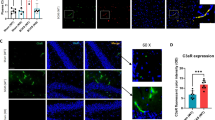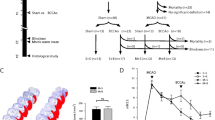Abstract
Vascular cognitive impairment (VCI) is the second most common cause of dementia. Reduced cerebral blood flow is thought to play a major role in the etiology of VCI. Therefore, chronic cerebral hypoperfusion has been used to model VCI in rodents. The goal of the current study was to determine the histopathological and neuroimaging substrates of neurocognitive impairments in a mouse model of chronic cerebral hypoperfusion induced by unilateral common carotid artery occlusion (UCCAO). Mice were subjected to sham or right UCCAO (VCI) surgeries. Three months later, neurocognitive function was evaluated using the novel object recognition task, Morris water maze, and contextual and cued fear-conditioning tests. Next, cerebral perfusion was evaluated with dynamic susceptibility contrast magnetic resonance imaging (MRI) using an ultra-high field (11.75 T) animal MRI system. Finally, brain pathology was evaluated using histology and T2-weighted MRI. VCI, but not sham, mice had significantly reduced cerebral blood flow in the right vs. left cerebral cortex. VCI mice showed deficits in object recognition. T2-weighted MRI of VCI brains revealed enlargement of lateral ventricles, which corresponded to areas of hippocampal atrophy upon histological analysis. In conclusion, our data demonstrate that the UCCAO model of chronic hypoperfusion induces hippocampal atrophy and ventricular enlargement, resulting in neurocognitive deficits characteristic of VCI.





Similar content being viewed by others
References
Iadecola C. The pathobiology of vascular dementia. Neuron. 2013;80(4):844–66. doi:10.1016/j.neuron.2013.10.008.
Gorelick PB, Scuteri A, Black SE, Decarli C, Greenberg SM, Iadecola C, et al. Vascular contributions to cognitive impairment and dementia: a statement for healthcare professionals from the American Heart Association/American Stroke Association. Stroke J Cereb Circ. 2011;42(9):2672–713. doi:10.1161/STR.0b013e3182299496.
Jiwa NS, Garrard P, Hainsworth AH. Experimental models of vascular dementia and vascular cognitive impairment: a systematic review. J Neurochem. 2010;115(4):814–28. doi:10.1111/j.1471-4159.2010.06958.x.
Yoshizaki K, Adachi K, Kataoka S, Watanabe A, Tabira T, Takahashi K, et al. Chronic cerebral hypoperfusion induced by right unilateral common carotid artery occlusion causes delayed white matter lesions and cognitive impairment in adult mice. Exp Neurol. 2008;210(2):585–91. doi:10.1016/j.expneurol.2007.12.005.
Shibata M, Ohtani R, Ihara M, Tomimoto H. White matter lesions and glial activation in a novel mouse model of chronic cerebral hypoperfusion. Stroke J Cereb Circ. 2004;35(11):2598–603. doi:10.1161/01.STR.0000143725.19053.60.
Zhao Y, Gu JH, Dai CL, Liu Q, Iqbal K, Liu F, et al. Chronic cerebral hypoperfusion causes decrease of O-GlcNAcylation, hyperphosphorylation of tau and behavioral deficits in mice. Front Aging Neurosci. 2014;6:10. doi:10.3389/fnagi.2014.00010.
Bink DI, Ritz K, Aronica E, van der Weerd L, Daemen MJ. Mouse models to study the effect of cardiovascular risk factors on brain structure and cognition. J Cereb Blood Flow Metab Off J Int Soc Cereb Blood Flow Metab. 2013;33(11):1666–84. doi:10.1038/jcbfm.2013.140.
Guo H, Itoh Y, Toriumi H, Yamada S, Tomita Y, Hoshino H, et al. Capillary remodeling and collateral growth without angiogenesis after unilateral common carotid artery occlusion in mice. Microcirculation. 2011;18(3):221–7. doi:10.1111/j.1549-8719.2011.00081.x.
Fuchtemeier M, Brinckmann MP, Foddis M, Kunz A, Po C, Curato C, et al. Vascular change and opposing effects of the angiotensin type 2 receptor in a mouse model of vascular cognitive impairment. J Cereb Blood Flow Metab Off J Int Soc Cereb Blood Flow Metab. 2014. doi:10.1038/jcbfm.2014.221.
Soria G, Tudela R, Marquez-Martin A, Camon L, Batalle D, Munoz-Moreno E, et al. The ins and outs of the BCCAo model for chronic hypoperfusion: a multimodal and longitudinal MRI approach. PLoS One. 2013;8(9):e74631. doi:10.1371/journal.pone.0074631.
Benice TS, Raber J. Object recognition analysis in mice using nose-point digital video tracking. J Neurosci Methods. 2008;168(2):422–30.
Anagnostaras SG, Wood SC, Shuman T, Cai DJ, LeDuc AD, Zurn KR et al. Automated assessment of Pavlovian conditioned freezing and shock reactivity in mice using the VideoFreeze system. Front Behav Neurosci. 2010;4. doi:10.3389/fnbeh.2010.00158.
Ostergaard L, Weisskoff R, Chesler D, Gyldensted C. High resolution measurement of cerebral blood flow using intravascular tracer bolus passages. Part I: mathematical approach and statistical analysis. MRM. 1996;36:715–25.
Pike MM, Stoops CN, Langford CP, Akella NS, Nabors LB, Gillespie GY. High-resolution longitudinal assessment of flow and permeability in mouse glioma vasculature: sequential small molecule and SPIO dynamic contrast agent MRI. Magn Reson Med. 2009;61(3):615–25. doi:10.1002/mrm.21931.
Meyer JS, Rauch GM, Rauch RA, Haque A, Crawford K. Cardiovascular and other risk factors for Alzheimer’s disease and vascular dementia. Ann N Y Acad Sci. 2000;903(1):411–23. doi:10.1111/j.1749-6632.2000.tb06393.x.
Fotuhi M, Do D, Jack C. Modifiable factors that alter the size of the hippocampus with ageing. Nat Rev Neurol. 2012;8(4):189–202.
Toyama K, Koibuchi N, Uekawa K, Hasegawa Y, Kataoka K, Katayama T, et al. Apoptosis signal-regulating kinase 1 is a novel target molecule for cognitive impairment induced by chronic cerebral hypoperfusion. Arterioscler Thromb Vasc Biol. 2014;34(3):616–25. doi:10.1161/ATVBAHA.113.302440.
Kitagawa K, Yagita Y, Sasaki T, Sugiura S, Omura-Matsuoka E, Mabuchi T, et al. Chronic mild reduction of cerebral perfusion pressure induces ischemic tolerance in focal cerebral ischemia. Stroke J Cereb Circ. 2005;36(10):2270–4. doi:10.1161/01.STR.0000181075.77897.0e.
Acknowledgments
The authors would like to acknowledge Erin Bidiman and Massarra Eiwaz for their assistance with the behavioral testing.
Compliance with Ethical Standards
ᅟ
Funding
This study was funded by the National Institutes of Health grants R21AG043857 (NJA), R01NS070837 (NJA), and F32NS082017 (KLZ) and the development account of JR.
Conflict of Interest
The authors declare that they have no competing interests.
Ethical Approval
All applicable international, national, and/or institutional guidelines for the care and use of animals were followed. This article does not contain any studies with human participants performed by any of the authors.
Author information
Authors and Affiliations
Corresponding author
Rights and permissions
About this article
Cite this article
Zuloaga, K.L., Zhang, W., Yeiser, L.A. et al. Neurobehavioral and Imaging Correlates of Hippocampal Atrophy in a Mouse Model of Vascular Cognitive Impairment. Transl. Stroke Res. 6, 390–398 (2015). https://doi.org/10.1007/s12975-015-0412-z
Received:
Revised:
Accepted:
Published:
Issue Date:
DOI: https://doi.org/10.1007/s12975-015-0412-z




